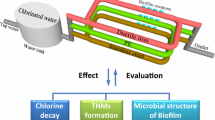Abstract
Free chlorine is a potent oxidizing agent and has been used extensively as a disinfectant in processes including water treatment. The presence of free chlorine residual is essential for the prevention of microbial regrowth in water distribution systems. However, excessive levels of free chlorine can cause adverse health effects. It is a major challenge to maintain appropriate levels of free chlorine residual in premise plumbing. As the first effort to assessing the fate of chlorine in premise plumbing using actual premise plumbing pipe sections, three piping materials frequently used in premise plumbing, i.e. copper, galvanized iron, and polyvinyl chloride (PVC), were investigated for their performance in maintaining free chlorine residual. Free chlorine decay was shown to follow first-order kinetics for all three pipe materials tested. The most rapid chlorine decay was observed in copper pipes, suggesting the need for higher chlorine dosage to maintain appropriate levels of free chlorine residual if copper piping is used. PVC pipes exhibited the least reactivity with free chlorine, indicative of the advantage of PVC as a premise plumbing material for maintaining free chlorine residual. The reactivity of copper piping with free chlorine was significantly hindered by the accumulation of pipe deposits. In contrast, the impact on chlorine decay by pipe deposits was not significant in galvanized iron and PVC pipes. Findings in this study are of great importance for the development of effective strategies for the control of free chlorine residual and prevention of microbiological contamination in premise plumbing.



Similar content being viewed by others
References
Al-Jasser AO (2007) Chlorine decay in drinking-water transmission and distribution systems: pipe service age effect. Water Res 41:387–396
Brown D, Bridgeman J, West JR (2011) Predicting chlorine decay and THM formation in water supply systems. Rev Environ Sci Bio/Technol 10:79–99
Brungs WA (1973) Effects of residual chlorine on aquatic life. J Water Pollut Control Fed 45:2180–2193
Chen S, He Q (2015) Persistence of Methanosaeta populations in anaerobic digestion during process instability. J Ind Microbiol Biotechnol 42:1129–1137
Clark RM, Rossman LA, Wymer LJ (1995) Modeling distribution system water quality: regulatory implications. J Water Resour Plan Manag ASCE 121:423–428
Digiano FA, Zhang W (2005) Pipe section reactor to evaluate chlorine—wall reaction. J Am Water Works Assoc 97:74–85
Frateur I, Deslouis C, Kiene L, Levi Y, Tribollet B (1999) Free chlorine consumption induced by cast iron corrosion in drinking water distribution systems. Water Res 33:1781–1790
Gauthier V, Gérard B, Portal JM, Block JC, Gatel D (1999) Organic matter as loose deposits in a drinking water distribution system. Water Res 33:1014–1026
Hallam NB, West JR, Forster CF, Powell JC, Spencer I (2002) The decay of chlorine associated with the pipe wall in water distribution systems. Water Res 36:3479–3488
Lee J, Lohani VK, Dietrich AM, Loganathan GV (2012) Hydraulic transients in plumbing systems. Water Sci Technol-Water Supply 12:619–629
Lehtola MJ, Miettinen IT, Lampola T, Hirvonen A, Vartiainen T, Martikainen PJ (2005) Pipeline materials modify the effectiveness of disinfectants in drinking water distribution systems. Water Res 39:1962–1971
Lu W, Kiéné L, Lévi Y (1999) Chlorine demand of biofilms in water distribution systems. Water Res 33:827–835
McGuire MJ (2006) Eight revolutions in the history of US drinking water disinfection. J Am Water Works Assoc 98:123
Nguyen CK, Powers KA, Raetz MA, Parks JL, Edwards MA (2011) Rapid free chlorine decay in the presence of Cu(OH)2: chemistry and practical implications. Water Res 45:5302–5312
Powell JC, West JR, Hallam NB, Forster CF, Simms J (2000) Performance of various kinetic models for chlorine decay. J Water Resour Plan Manag ASCE 126:13–20
Rossman LA, Clark RM, Grayman WM (1994) Modeling chlorine residuals in drinking-water distribution systems. J Environ Eng 120:803–820
Szewzyk U, Szewzyk R, Manz W, Schleifer KH (2000) Microbiological safety of drinking water. Annu Rev Microbiol 54:81–127
Vreeburg JHG, Schippers D, Verberk JQJC, Van Dijk JC (2008) Impact of particles on sediment accumulation in a drinking water distribution system. Water Res 42:4233–4242
Wang H, Edwards MA, Falkinham JO, Pruden A (2013) Probiotic approach to pathogen control in premise plumbing systems? A review. Environ Sci Technol 47:10117–10128
Weisel CP, Kim H, Haltmeier P, Klotz JB (1999) Exposure estimates to disinfection by-products of chlorinated drinking water. Environ Health Perspect 107:103–110
Zacheus OM, Lehtola MJ, Korhonen LK, Martikainen PJ (2001) Soft deposits, the key site for microbial growth in drinking water distribution networks. Water Res 35:1757–1765
Zhang Y (2012) Microbial community dynamics and assembly: drinking water treatment and distribution. PhD Dissertation, University of Tennessee
Zhang Y, He Q (2013) Characterization of bacterial diversity in drinking water by pyrosequencing. Water Sci Technol-Water Supply 13:358–367
Acknowledgments
We thank Si Chen and Joshua Frerichs for technical assistance with water sampling and analysis. This work was supported by U.S. National Science Foundation Grant CBET0854332 and the Institute for a Secure and Sustainable Environment at the University of Tennessee, Knoxville.
Author information
Authors and Affiliations
Corresponding author
Ethics declarations
Conflict of interest
The authors declare that they have no conflict of interest.
Research involving human and animal rights
This article does not contain any studies with human participants or animals performed by any of the authors.
Rights and permissions
About this article
Cite this article
Zheng, M., He, C. & He, Q. Fate of free chlorine in drinking water during distribution in premise plumbing. Ecotoxicology 24, 2151–2155 (2015). https://doi.org/10.1007/s10646-015-1544-3
Accepted:
Published:
Issue Date:
DOI: https://doi.org/10.1007/s10646-015-1544-3




